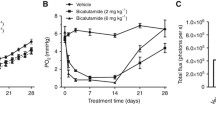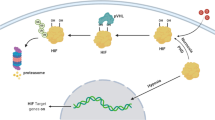Abstract
Upregulation of vascular endothelial growth factor (VEGF) expression induced by hypoxia is crucial event leading to neovascularization. Cyclooxygenase-2, an inducible enzyme that catalyzes the formation of prostaglandins (PGs) from arachidonic acid, has been demonstrated to be induced by hypoxia and play role in angiogenesis and metastasis. To investigate the potential effect of COX-2 on hypoxia-induced VEGF expression in prostate cancer. We examined the relationship between COX-2 expression and VEGF induction in response to cobalt chloride (CoCl2)-simulated hypoxia in three human prostate cancer cell lines with differing biological phenotypes. Northern blotting and ELISA revealed that all three tested cell lines constitutively expressed VEGF mRNA, and secreted VEGF protein to different degrees (LNCaP > PC-3 > PC3ML). However, these cell lines differed in the ability to produce VEGF in the presence of CoCl2-simulated hypoxia. CoCl2 treatment resulted in 40% and 75% increases in VEGF mRNA, and 50% and 95% in protein secretion by LNCaP and PC-3 cell lines, respectively. In contrast, PC-3ML cell line, a PC-3 subline with highly invasive, metastatic phenotype, exhibits a dramatic upregulation of VEGF, 5.6-fold in mRNA and 6.3-fold in protein secretion after treatment with CoCl2. The upregulation of VEGF in PC-3ML cells is accompanied by a persistent induction of COX-2 mRNA (6.5-fold) and protein (5-fold). Whereas COX-2 expression is only transiently induced in PC-3 cells and not affected by CoCl2 in LNCaP cells. Moreover, the increases in VEGF mRNA and protein secretion induced by CoCl2 in PC-3ML cells were significantly suppressed following exposure to NS398, a selective COX-2 inhibitor. Finally, the effect of COX-2 inhibition on CoCl2-induced VEGF production was reversed by the treatment with exogenous PGE2. Our data demonstrate that VEGF induction by cobalt chloride-simulated hypoxia is maintained by a concomitant, persistent induction of COX-2 expression and sustained elevation of PGE2 synthesis in a human metastatic prostate cancer cell line, and suggest that COX-2 activity, reflected by PGE2 production, is involved in hypoxia-induced VEGF expression, and thus, modulates prostatic tumor angiogenesis.
Similar content being viewed by others
References
Folkman J. What is the evidence that tumors are angiogenesis dependent? J Natl Cancer Inst 1990; 82: 4–6.
Bunn HF, Poyton RO. Oxygen sensing and molecular adaptation to hypoxia. Physiol Rev 1996; 76: 839–85.
Wang GL, Semenza GL. Characterization of hypoxia-inducible factor-1 and regulation of DNA binding activity by hypoxia. J Biol Chem 1993; 268: 21513–8.
Guillemin K, Krasnow MA. The hypoxic response: Huffing and HIFing. Cell 1997; 89: 9–12.
Damert A, Ikeda E, Risau W. Activator-protein-1 binding potentials the hypoxia-inducible factor-1 mediated hypoxia-induced transcriptional activation of vascular endothelial growth factor expression in C6 glioma. Biochem J 1997; 327: 419–23.
Taketo MM. Cyclooxygenase-2 inhibitor in tumorigenesis (Part II). J Natl Cancer Inst 1998; 90: 1609–20.
Tjandrawinata RR, Dahiya R, Hughes-Fulford M. Induction of cyclooxygenase-2 mRNA by prostaglandin E2 in human prostatic carcinoma cells. Br J Cancer 1997; 75: 1111–8.
Tsujii M, DuBois RN. Alterations in cellular adhesion and apoptosis in epithelial cells overexpressing prostaglandin endoperoxide synthase-2. Cell 1995; 83: 493–501.
Liu XH, Rose DP. Differential expression and regulation of cyclooxygenase-1 and-2 in two human breast cancer cell lines. Cancer Res 1996; 56: 5125–7.
Tsujii M, Kawano S, DuBois RN. Cyclooxygenase-2 expression in human colon cancer cells increases metastatic potential. Proc Natl Acad Sci USA 1997; 94: 3336–40.
Tsujii M, Kawano S, Tsuji S, DuBois RN. Cyclooxygenase regulates angiogenesis induced by colon cancer cells. Cell 1998; 93: 705–16.
Schmedtji JF Jr., Ji YS, Liu WL et al. Hypoxia induces cyclooxygenase-2 via the NF-kB p65 transcription factor in human vascular endothelial cells. J Biol Chem 1997; 272: 601–8.
Form DM, Auerbach R. Prostaglandin E2 and angiogenesis. Proc Soc Exp Biol Med 1983; 172: 214–8.
Brawer MK, Deering RE, Brown M et al. Predictors of pathologic stage in prostatic carcinomas: The role of neovascularity. Cancer 1994; 73: 678–87.
Weidner N, Carroll PR, Flax J et al. Tumor angiogenesis correlates with metastasis in invasive prostate carcinoma. Am J Pathol 1993; 143: 401–9.
Lissbrant IF, Stattin P, Damber JE, Bergh A. Vascular density is a predictor of cancer-specific survival in prostatic carcinoma. Prostate 1997; 33: 38–45.
Toi M, Hoshina S, Takayanagi T, Tominaga T. Association of vascular endothelial growth factor expression with tumor angiogenesis and with early relapse in primary breast cancer. Jpn J Cancer Res 1994; 85: 1045–52.
Mattern J, Koomagi R, Volm M. Association of vascular endothelial growth factor expression with intratumoral microvessel density and tumor cell proliferation in human epidermoid lung carcinoma. Br J Cancer 1996; 73: 931–9.
Connolly JM, Rose DP. Angiogenesis in two human prostate cancer cell lines with differing metastatic potential when growing as solid tumors in nude mice. J Urol 1998; 160: 932–6.
Connolly JM, Rose DP. A comparison of the expression of the malignant phenotype in two androgen-independent human prostate cancer cell lines after orthotopic implantation in nude mice. Int J Oncol 1997; 11: 771–6.
Goldberg MA, Schneider TJ. Similarities between the oxygen-sensing mechanisms regulating the expression of vascular endothelial growth factor and erythropoietin. J Biol Chem 1994; 269: 4355–9.
Wang M, Stearns ME. Isolation and characterization of PC-3 human prostate tumor sublines which preferentially metastasize to select organs in SCID mice. Differentiation 1991; 48: 115–25.
Levine AC, Liu XH, Greenberg PD et al. Androgens induce the expression of vascular endothelial growth factor in human fetal prostatic fibroblasts. Endocrinology 1998; 139: 4672–8.
Nie DT, Hillman GG, Geddes T et al. Platelet-type 12-lipoxygenase in a human prostate carcinoma stimulates angiogenesis and tumor growth. Cancer Res 1998; 58: 4047–51.
Yang M, Sytkowski AJ. Cloning differentially expressed genes by linker capture subtraction. Anal Biochem 1996; 237: 109–14.
Shweiki D, Itin A, Soffer D, Kesher E. Vascular endothelial growth factor induced by hypoxia may mediate hypoxia-induced angiogenesis. Nature (London) 1992; 359: 843–5.
Damert A, Machein M, Breier G et al. Upregulation of vascular endothelial growth factor expression in a rat glioma is conferred by two distinct hypoxia-driven mechanisms. Cancer Res 1997; 57: 3860–4.
Han JW, Sadowski H, Young DA, Macara IG. Persistent induction of cyclooxygenase in p60v–src –transformed 3T3 fibroblasts. Proc Natl Acad Sci USA 1990; 87: 3373–7.
Rolland PH, Martin PM, Jacquemier J et al. Prostaglandins in human breast cancer: evidence suggesting that an elevated prostaglandin production is a marker of high metastatic potential for neoplastic cells. J Natl Cancer Inst 1980; 64: 1061–70.
Semenza GL, Wang GL. A nuclear factor induced by hypoxia via de novo protein synthesis binds to the human erythropoietin gene enhancer at a site required for transcriptional activation. Mol Cell Biol 1994; 12: 5447–54.
Appleby SB, Ristimaki A, Neilson K et al. Structure of the human cyclooxygenase-2 gene. Biochem J 1994; 302: 723–7.
Kraemer SA, Arthur KA, Dension MS et al. Regulation of prostaglandin endoperoxide H synthase-2 expression by 2,3,7,8-tetrachlorodibenzo-p-dioxin. Arch Biochem Biophys 1996; 330: 319–28.
Harada S, Nagy JA, Sullivan KA et al. Induction of vascular endothelial growth factor expression by prostaglandin E2 and E1 in osteoblasts. J Clin Invest 1994; 93: 2490–6.
Ben-Av P, Crofford LJ, Wilder RL, Hla T. Induction of vascular endothelial growth factor expression in synovial fibroblasts by prostaglandin E and interleukin-1: A potential mechanism for inflammatory angiogenesis. FEBS Lett 1995; 372: 83–7.
Warner TD, Giuliano F, Vojnovic I et al. Nonsteroid drug selectivities for cyclooxygenase-1 rather than cyclooxygenase-2 are associated with human gastrointestinal toxicity: a full in vitro analysis. Proc Natl Acad Sci USA 1999; 96: 7563–8.
Masferrer JL, Zweifel BS, Manning PT et al. Selective inhibition of inducible cyclooxygenase 2 in vivo is antiinflammatory and nonulcerogenic. Proc Natl Acad Sci USA 1994; 91: 3228–32.
Futaki N, Yoshikawa K, Hamasaka Y et al. NS398, a novel nonsteroidal anti-inflammatory drug with potent analgestic and antipyretic effects, which causes minimal stomach lesions. Gen Pharmacol 1993; 24: 105–10.
Liu XH, Yao S, Kirschenbaum A, Levine AC. NS398, a selective cyclooxygen-ase-2 inhibitor, induces apoptosis and down-regulates bcl-2 expression in LNCaP cells. Cancer Res 1998; 58: 4245–9.
Author information
Authors and Affiliations
Rights and permissions
About this article
Cite this article
Liu, XH., Kirschenbaum, A., Yao, S. et al. Upregulation of vascular endothelial growth factor by cobalt chloride-simulated hypoxia is mediated by persistent induction of cyclooxygenase-2 in a metastatic human prostate cancer cell line. Clin Exp Metastasis 17, 687–694 (1999). https://doi.org/10.1023/A:1006728119549
Issue Date:
DOI: https://doi.org/10.1023/A:1006728119549




